| 5 November |
• yesterday • tomorrow |
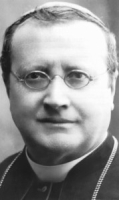
As a child he used to have conversations in his parish church with Christ crucified. Entered the seminary in Parma, Italy at age 17. Ordained on 22 September 1888. Professor at the seminary. Vice-rector of the seminary. Vicar of Clergy in the diocese of Parma. Founded the Xaverian Missionaries on 3 December 1895; they were assigned by Rome to evangelize China. Archbishop of Ravenna, Italy on 9 June 1902. Resigned as archbishop due to poor health in October 1904. Coadjutor bishop of Parma, Italy and titular archbishop of Stauropolis on 14 November 1904. Archbishop of Parma, Italy on 12 December 1907. He visited his parishes regularly, worked for religious formation, supported religious education for the laity and lay involvement with youth. In 1928 he travelled to China to visit the Xaverians working there.
30 March 1865 at Ravadese, Parma, Italy
• 5 November 1931 in Parma, Italy of natural causes
• buried in the center of the apse of the church of the motherhouse of the Xaverian Missionaries in Parma
• 17 March 1996 by Pope John Paul II in Rome, Italy
• the beatification miracle involved the cure of 12 year old Sabina Kamariza's pancreatic cancer in Burundi, Africa in 1965
23 October 2011 by Pope Benedict XVI
Xaverian Missionaries
Christ is all things. - Saint Guido's personal motto
https://catholicsaints.info/saint-guido-maria-conforti/
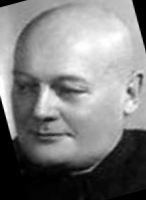
Narcissus Putz
12 June as one of the 108 Martyrs of World War II
Priest at Saint Wojciech parish, Poznan, Poland. Arrested in the Nazi anti-Catholic sweeps of 1939 and sent to the Catholic clergy section of the Dachau concentration camp. There he continued his ministry by caring for other prisoners and suffering his own privations in quiet dignity. Martyr.
28 October 1877 in Sieraków, Wielkopolskie, Poland
5 December 1942 in the Dachau concentration camp, Oberbayern, Germany from disease and general abuse
13 June 1999 by Pope John Paul II
Father Putz belonged to the first transport of Polish prisoners to Dachau. A 65-year-old priest, emaciated and ailing, but young in heart and spirit, he sensed that he would not return to his country, but he comforted and uplifted his brothers with his optimism and the joyful reception of God’s experience. He enjoyed the sympathy of all Polish prisoners. - Father Gerard Mizgalski
https://catholicsaints.info/blessed-narcyz-putz/
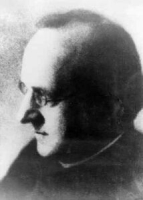
Priest in the diocese of Berlin, Germany. He served in the Berlin Cathedral, and was well known in civic circles. An out-spoken critic of the Nazis and their anti-Semitism, Father Berhard organized protests outside the concentration camps, led public prayers for the Jews after the terrors of Krystallnacht, and filed formal complaints against the racist policies of the party. For these works he was imprisoned for two years. Upon his release he immediately resumed his ministry, both pastoral and social. He was arrested again, sentenced to the Dachau concentration camp, but died en route. Martyr.
3 December 1875 at Ohlau, Germany
martyred on 5 November 1943 in a cattle car at Hof, Germany while en route to the Dachau concentration camp
23 June 1996 by Pope John Paul II at the Olympic Stadium, Berlin, Germany
https://catholicsaints.info/blessed-bernhard-lichtenberg/
• Gerald of Puissalicon
• Guiraud, Geraud, Geraldo
Augustinian canon regular. Deacon in 1094; ordained to the priesthood in 1101. Abbot of Cassan Abbey near Roujan, France in 1105. Bishop of Beziers, France in 1121. Spent all his diocese's revenues to care for the poor.
c.1070 at Puissalicon, France
• 5 November 1123 in Beziers, France of natural causes
• buried near Saint Aphrodise, first bishop of Beziers
• relics transferred to a nearby, but now defunct, Poor Clare convent in Beziers on 11 November 1259
• relics enshrined at the church of Saint Aphrodise in 1355
• relics destroyed in 1793 during the anti-Christianity excesses of the French Revolution
• a silver and amethyst ring that belonged to Gerald has survived, but was stolen in 1980
bishop distributing alms
https://catholicsaints.info/saint-gerald-of-beziers/
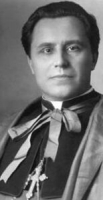
Gregor, Gregory, Hryhorij, Hryhory
27 June as one of the Martyrs Killed Under Communist Regimes in Eastern Europe
Greek Catholic. Studied theology at Lviv, Ukraine. Ordained in 1908 at Przemysl (in modern Poland). Doctor of theology at Vienna, Austria in 1911. Professor at the Ukrainian seminary at Przemysl in 1913. Rector of the seminary. Auxiliary bishop of Przemysl, Poland on 16 May 1926. Arrested for his faith on 9 June 1946; sentenced to ten years at Vorkuta, Russia. Died in prison. One of the Martyrs Killed Under Communist Regimes in Eastern Europe.
31 January 1883 at Holodivka, Lviv District, Ukraine
12 November 1950 at Abez, Vorkuta, Russia
27 June 2001 by Pope John Paul II in Ukraine
https://catholicsaints.info/blessed-hryhorii-lakota/
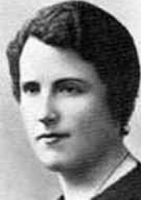
Lay woman in the archdiocese of Valencia, Spain. Baptized at the age of two days, and made her First Communion on 24 April 1904 in her home parish of Saint Peter the Apostle. Worked as a seamstress. Studied sociology; she worked with working young people, and brought the Salesian Sisters to the region in 1931 to help with the religious education of young people. She was devoted to Eucharistic adoration, regular Communion, and prayed the rosary every day. Member of Catholic Action. Martyred in the Spanish Civil War.
27 November 1893 in Sueca, Valencia, Spain
5 November 1936 in El Saler, Valencia, Spain
11 March 2001 by Pope John Paul II
https://catholicsaints.info/blessed-maria-del-carmen-viel-ferrando/
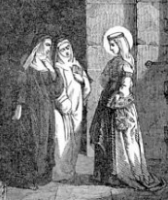
Bertilla
French noble in the reign of King Dagobert I. Friend and spiritual student of Saint Ouen of Rouen. Bertille wanted to enter religious life, but delayed and worried, thinking her parents would oppose her choice; they did not. Benedictine nun at the convent at Jouarre, Brie, France, an abbey founded by Saint Owen's brother Ado under the strict rule of Saint Columbanus. Infirmarian. Convent school headmistress. Prioress. Abbess of the abbey at Chelles from 646, when it was restored by Saint Bathildis, until her death. During this time the convent attracted nuns that included a queen, several Merovingian princesses, and many Anglo-Saxon noble women.
at Soissons, France
c.703
https://catholicsaints.info/saint-bertille/
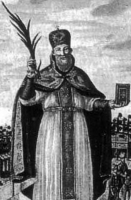
• Gomida Keumurgian
• Cosma de Carboniano
Married at age 20. Priest in the Armenian church. In 1696 he and his family made complete submission to the authority of Rome. This angered Armenian officials who took this as an insult. Some of them falsely accused Gomidas of being a spy for Rome, which led to his arrest and execution by Turkish authorities. Considered a martyr as his death was the result of his faith.
c.1656 at Constantinople
beheaded 1707 at Parmark-Kapu, Constantinople
23 June 1929 by Pope Pius XI
https://catholicsaints.info/blessed-gomidas-keumurjian/
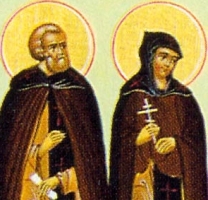
Saint Galation was a Christian married to Epistemis, and brought her to the faith. They both then retired to monasteries and were later martyred in the persecutions of Decius. It's possible they were fictional, the story of their lives being written as fiction but misunderstood as fact; however, married couples agreeing to enter religious life was not unusual at the time.
251 at Emessa, Pheonicia
https://catholicsaints.info/saint-epistemis/
https://catholicsaints.info/saint-galation/
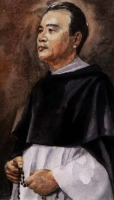
Dominic
24 November as one of the Martyrs of Vietnam
Dominican. Priest. Promoted the use of the Rosary to strengthen the faith of Christians. Imprisoned in the persecutions of emperor Tu-Duc, he ministered to other prisoners until he was executed. Martyr.
c.1794 in Phú Nhai, Nam Ðinh, Vietnam
beheaded 5 November 1858 by the river in Hung Yên, Vietnam
19 June 1988 by Pope John Paul II
https://catholicsaints.info/saint-daminh-mau/
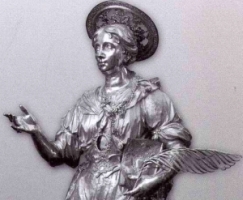
Martyr.
• 3rd century Rome, Italy
• buried in the catacombs of Saint Agnes, Nomentana, Rome
• relics enshrined in Martina Franca, Italy in 1646 by Cardinal Sacrati with the approval of Pope Innocent X
• rain is reported to have followed the procession that delivered her relics, which led to her patronage against drought
• against drought
• Martina Franca, Italy
https://catholicsaints.info/saint-comasia/
Lie, Lié, Lyé, Laetus
Monk from age 12. Priest. Spiritual advisor to Saint Leonard of Noblac.
region of Berry, France
• 533 in the forest of Orléans, France of natural causes
• relics enshrined in Saint-Lié-la-Forêt, France
https://catholicsaints.info/saint-laetus-of-orleans/
Mamet
17 August in the diocese of Saint-Flour, France
Priest. Evangelist in the region of Saint-Flour, France, assigned by Saint Astremonius of Clermont, France. The town of Saint-Mamet-la-Salvetat, France is named for him.
4th century Auvergne, France of natural causes
https://catholicsaints.info/saint-mamete/
Kay, Ke, Kenan, Quay
Born to the nobility. Ministered in Devon and Cornwall, where Landkey is named for him, and in Brittany where he was known as Quay.
at Glastonbury, England
6th century
against toothaches
with a stag
https://catholicsaints.info/saint-kea/
Donnino
Physician condemned to work the mines during the persecutions of Maximian. Martyr.
burned to death in 310 in Palestine
https://catholicsaints.info/saint-domninus-the-physician/
Born to the southern German nobility, Idda spent as much of her time in prayer as possible. Married. Widowed, she spent her final days at the Benedictine abbey of Fischingen, Germany.
12th century of natural causes
https://catholicsaints.info/saint-idda/
Spin, Spinula
Monk at Moyenmoutier, France. Friend of Saint Hidulf. Founded the monastery of Bégon-Celle (now known as Saint-Blasien) in France.
c.714
https://catholicsaints.info/saint-spinulus/
Benedictine monk at Salcedo, diocese of Tui, Spanish Galatia. Helped Saint Rudesind spread the Benedictine Rule throughout northwest Spain.
Spanish
953
https://catholicsaints.info/saint-hermenegild/
Sixth century Benedictine monk. Dispatched by Saint Benedict of Nursia to found a monastery in Terracina, Italy.
https://catholicsaints.info/saint-augustine-of-terracina/
Bishop condemned to work the mines during the persecutions of Maximian. Martyr.
Syrian
https://catholicsaints.info/saint-sylvanus-of-syria/
Fibizio, Fibicio
Abbot of a monastery in Trier, Germany. Bishop of Trier.
c.500
https://catholicsaints.info/saint-fibitius/
Martyr.
1st century in Terracina, Italy
https://catholicsaints.info/saint-eusebius-of-terracina/
Brother monk of Saint Winwallus and Saint Giacuto at Landevennec monastery in Brittany, France. Abbot.
https://catholicsaints.info/saint-guetnoco/
Cannen
Founder of Llanganten abbey, Powys, Wales.
8th century
https://catholicsaints.info/saint-kanten/
Bishop of Brescia, Italy.
c.495
https://catholicsaints.info/saint-dominator-of-brescia/
Martyr.
1st century in Terracina, Italy
https://catholicsaints.info/saint-felix-of-terracina/
Daughter of a prince of Constantinople. Hermitess in the desert of Jordan.
https://catholicsaints.info/saint-canonica/
Bishop of Troia, Italy.
https://catholicsaints.info/saint-marco-of-troia/
Four young Christian men who were martyred together in the persecutions of Maximian - Aussenzius, Philotheus, Timothy and Theotimus.
in the arena at Caesarea Maritima, Palestine
https://catholicsaints.info/martyrs-of-caesarea-maritima/
Thousands of people were murdered in the anti-Catholic persecutions of the Spanish Civil War from 1934 to 1939. I have pages on each of them, but in most cases I have only found very minimal information. They are available on the CatholicSaints.Info site through these links:
• Blessed Juan Antoni Burró Mas
• Blessed Juan Duarte Martín
• Blessed María del Carmen Viel Ferrando

• Society of Jesus
• Company of Jesus
1534 by Saint Ignatius Loyola at Montmartre, Paris, France
A body of clerics regular organized for Apostolic work, following a religious rule and relying on alms for their support. It was the chief instrument of the Catholic Reformation. Pope Paul III approved the new rule in 1540, and Ignatius was elected the first general of the order in 1541. The constitutions, drafted by him and based on his Spiritual Exercies were adopted in 1558. It was the first order which enjoined by its constitutions devotion to the cause of education. The ministry of the Society consists chiefly in preaching; teaching catechism; administering the sacraments; conducting missions in parishes; taking care of parishes; organizing pious confraternities; teaching in schools of every grade; writing books, pamphlets, periodical articles; going on foreign missions, and special missions when ordered by the pope. The general resides at Rome, Italy and has a council of assistants. The motto of the Society is Ad Majorem Dei Gloriam (For the greater glory of God).
•
https://catholicsaints.info/jesuits/
• Holy Relics
• Beatrice of Swabia
• Tigrino of Rome
• Trofimena of Sicily
CatholicSaints.Info Portable Edition